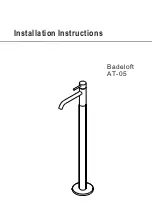
Fig. 9:
Flange connection CF-F, stud screw and through hole
Connection of the stud screw and through hole
1. For the connection of the turbopump, use only the approved mounting kits from Pfeiffer Vacuum.
2. If used: Insert the protective screen or splinter shield with clamping lugs downwards in the turbo-
pump high vacuum flange.
3. Place the seal exactly in the hollow.
4. Connect the flange with the components of the mounting kit according to the figure.
5. Tighten the screw couplings all the way around.
– Tightening torque:
22 ± 2 Nm
6. Then check the torque, since flowing of the sealing material may make it necessary to re-tighten
the screws.
5.3 Connecting fore-vacuum side
WARNING
Danger to life from poisoning where toxic process media leak from damaged connections
Sudden twisting of the turbopump in the event of a fault causes fittings to accelerate. There is the risk
of damaging on-site connections (e.g., fore-vacuum line) and resulting leaks. This results in leakage
of process media. In processes involving toxic media, there is a risk of injury and danger to life due to
poisoning.
► Keep masses connected to the turbopump as low as possible.
► Use flexible lines to connect to the turbopump where necessary.
Suitable backing pump
Use the turbopump only in combination with a suitable backing pump that can deliver up to
the required maximum fore-vacuum pressure. To achieve the fore-vacuum pressure, use a
suitable vacuum pump or a pumping station from the Pfeiffer Vacuum range.
In this case, the backing pump is also controlled directly via the turbopump electronic drive
unit interfaces (e.g., relay box or connection cable).
6
4
3
2
1
5
Fig. 10:
Example of fore-vacuum connection on MVP
1 Turbopump fore-vacuum connection
4
Circlip
2 Screw-in flange, 1/4” thread
5
Backing pump (e.g., diaphragm pump)
3 Centering ring
6
Vacuum components
Installation
28/58
















































